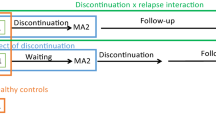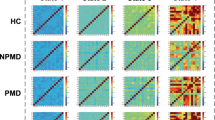Abstract
Electroconvulsive therapy (ECT) is effective even in treatment-resistant patients with major depression. Currently, there are no markers available that can assist in identifying those patients most likely to benefit from ECT. In the present study, we investigated whether resting-state network connectivity can predict treatment outcome for individual patients. We included forty-five patients with severe and treatment-resistant unipolar depression and collected functional magnetic resonance imaging scans before the course of ECT. We extracted resting-state networks and used multivariate pattern analysis to discover networks that predicted recovery from depression. Cross-validation revealed two resting-state networks with significant classification accuracy after correction for multiple comparisons. A network centered in the dorsomedial prefrontal cortex (including the dorsolateral prefrontal cortex, orbitofrontal cortex and posterior cingulate cortex) showed a sensitivity of 84% and specificity of 85%. Another network centered in the anterior cingulate cortex (including the dorsolateral prefrontal cortex, sensorimotor cortex, parahippocampal gyrus and midbrain) showed a sensitivity of 80% and a specificity of 75%. These preliminary results demonstrate that resting-state networks may predict treatment outcome for individual patients and suggest that resting-state networks have the potential to serve as prognostic neuroimaging biomarkers to guide personalized treatment decisions.
This is a preview of subscription content, access via your institution
Access options
Subscribe to this journal
Receive 12 print issues and online access
$259.00 per year
only $21.58 per issue
Buy this article
- Purchase on Springer Link
- Instant access to full article PDF
Prices may be subject to local taxes which are calculated during checkout



Similar content being viewed by others
References
Lisanby SH . Electroconvulsive therapy for depression. N Engl J Med 2007; 357: 1939–1945.
Murray CJ, Abraham J, Ali MK, Alvarado M, Atkinson C, Baddour LM, et al. The State of US Health, 1990–2010: burden of diseases, injuries, and risk factors. JAMA 2013; 310: 591–608.
Rush AJ, Trivedi MH, Wisniewski SR, Nierenberg AA, Stewart JW, Warden D, et al. Acute and longer-term outcomes in depressed outpatients requiring one or several treatment steps: a STAR*D report. Am J Psychiatry 2006; 163: 1905–1917.
Prudic J, Olfson M, Marcus SC, Fuller RB, Sackeim HA . Effectiveness of electroconvulsive therapy in community settings. Biol Psychiatry 2004; 55: 301–312.
Goodman WK . Electroconvulsive therapy in the spotlight. N Engl J Med 2011; 364: 1785–1787.
Sackeim HA, Prudic J, Fuller R, Keilp J, Lavori PW, Olfson M . The cognitive effects of electroconvulsive therapy in community settings. Neuropsychopharmacology 2007; 32: 244–254.
Heijnen WT, Birkenhager TK, Wierdsma AI, van den Broek WW . Antidepressant pharmacotherapy failure and response to subsequent electroconvulsive therapy: a meta-analysis. J Clin Psychopharmacol 2010; 30: 616–619.
Case BG, Bertollo DN, Laska EM, Price LH, Siegel CE, Olfson M, et al. Declining use of electroconvulsive therapy in United States general hospitals. Biol Psychiatry 2013; 73: 119–126.
Petrides G, Fink M, Husain MM, Knapp RG, Rush AJ, Mueller M, et al. ECT remission rates in psychotic versus nonpsychotic depressed patients: a report from CORE. J ECT 2001; 17: 244–253.
Loo CK, Mahon M, Katalinic N, Lyndon B, Hadzi-Pavlovic D . Predictors of response to ultrabrief right unilateral electroconvulsive therapy. J Affect Disord 2011; 130: 192–197.
Kellner CH, Popeo DM, Pasculli RM, Briggs MC, Gamss S . Appropriateness for electroconvulsive therapy (ECT) can be assessed on a three-item scale. Med Hypotheses 2012; 79: 204–206.
American Psychiatric Association. Consensus report of the APA Work Group on Neuroimaging Markers of Psychiatric Disorders. American Psychiatric Association: Arlington, VA, USA, 2012.
Craddock RC, Holtzheimer PE 3rd, Hu XP, Mayberg HS . Disease state prediction from resting state functional connectivity. Magn Reson Med 2009; 62: 1619–1628.
Zeng LL, Shen H, Liu L, Wang L, Li B, Fang P, et al. Identifying major depression using whole-brain functional connectivity: a multivariate pattern analysis. Brain 2012; 135: 1498–1507.
Fu CH, Mourao-Miranda J, Costafreda SG, Khanna A, Marquand AF, Williams SC, et al. Pattern classification of sad facial processing: toward the development of neurobiological markers in depression. Biol Psychiatry 2008; 63: 656–662.
Costafreda SG, Khanna A, Mourao-Miranda J, Fu CH . Neural correlates of sad faces predict clinical remission to cognitive behavioural therapy in depression. NeuroReport 2009; 20: 637–641.
van Waarde JA, van Oudheusden LJB, Heslinga OB, Verwey B, van der Mast RC, Giltay E . Patient, treatment, and anatomical predictors of outcome in electroconvulsive therapy: a prospective study. J ECT 2013; 29: 113–121.
van Waarde JA, van Oudheusden LJB, Tonino BA, van der Wee NJ, Verwey B, van der Mast RC, et al. MRI characteristics predicting seizure threshold in patients undergoing electroconvulsive therapy: a prospective study. Brain Stimul 2013; 6: 607–614.
Montgomery SA, Asberg M . A new depression scale designed to be sensitive to change. Br J Psychiatry 1979; 134: 382–389.
Zimmerman M, Chelminski I, Posternak M . A review of studies of the Hamilton depression rating scale in healthy controls: implications for the definition of remission in treatment studies of depression. J Nerv Ment Dis 2004; 192: 595–601.
Beckmann CF, DeLuca M, Devlin JT, Smith SM . Investigations into resting- state connectivity using independent component analysis. Philos Trans R Soc Lond Ser B 2005; 360: 1001–1013.
Smith SM, Nichols TE . Threshold-free cluster enhancement: addressing problems of smoothing, threshold dependence and localisation in cluster inference. NeuroImage 2009; 44: 83–98.
Fu CH, Steiner H, Costafreda SG . Predictive neural biomarkers of clinical response in depression: a meta-analysis of functional and structural neuroimaging studies of pharmacological and psychological therapies. Neurobiol Dis 2013; 52: 75–83.
Sheline YI, Price JL, Yan Z, Mintun MA . Resting-state functional MRI in depression unmasks increased connectivity between networks via the dorsal nexus. Proc Natl Acad Sci USA 2010; 107: 11020–11025.
Alexopoulos GS, Murphy CF, Gunning-Dixon FM, Latoussakis V, Kanellopoulos D, Klimstra S, et al. Microstructural white matter abnormalities and remission of geriatric depression. Am J Psychiatry 2008; 165: 238–244.
McCormick LM, Boles Ponto LL, Pierson RK, Johnson HJ, Magnotta V, Brumm MC . Metabolic correlates of antidepressant and antipsychotic response in patients with psychotic depression undergoing electroconvulsive therapy. J ECT 2007; 23: 265–273.
Abbott CC, Lemke NT, Gopal S, Thoma RJ, Bustillo J, Calhoun VD, et al. Electroconvulsive therapy response in major depressive disorder: a pilot functional network connectivity resting state FMRI investigation. Front Psychiatry 2013; 4: 10.
Perrin JS, Merz S, Bennett DM, Currie J, Steele DJ, Reid IC, Schwarzbauer C . Electroconvulsive therapy reduces frontal cortical connectivity in severe depressive disorder. Proc Natl Acad Sci USA 2012; 109: 5464–5468.
Dukart J, Regen F, Kherif F, Colla M, Bajbouj M, Heuser I, et al. Electroconvulsive therapy-induced brain plasticity determines therapeutic outcome in mood disorders. Proc Natl Acad Sci USA 2014; 111: 1156–1161.
Costafreda SG, Chu C, Ashburner J, Fu CH . Prognostic and diagnostic potential of the structural neuroanatomy of depression. PLoS One 2009; 4: e6353.
Gong Q, Wu Q, Scarpazza C, Lui S, Jia Z, Marquand A, et al. Prognostic prediction of therapeutic response in depression using high-field MR imaging. NeuroImage 2011; 55: 1497–1503.
Greicius M . Resting-state functional connectivity in neuropsychiatric disorders. Curr Opin Neurol 2008; 21: 424–430.
Abrams R . Electroconvulsive Therapy. 4th edn Oxford University Press: New York, NY, USA, 2002.
Nobler MS, Oquendo MA, Kegeles LS, Malone KM, Campbell CC, Sackeim HA, et al. Decreased regional brain metabolism after ECT. Am J Psychiatry 2001; 158: 305–308.
Kellner CH, Greenberg RM, Murrough JW, Bryson EO, Briggs MC, Pasculli RM . ECT in treatment-resistant depression. Am J Psychiatry 2012; 169: 1238–1244.
Bolwig TG . How does electroconvulsive therapy work? Theories on its mechanism. Can J Psychiatry 2011; 56: 13–18.
McCabe C, Mishor Z . Antidepressant medications reduce subcortical–cortical resting-state functional connectivity in healthy volunteers. NeuroImage 2011; 57: 1317–1323.
Van Dijk KR, Hedden T, Venkataraman A, Evans KC, Lazar SW, Buckner RL . Intrinsic functional connectivity as a tool for human connectomics: theory, properties, and optimization. J Neurophysiol 2010; 103: 297–321.
Biswal BB, Mennes M, Zuo XN, Gohel S, Kelly C, Smith SM, et al. Toward discovery science of human brain function. Proc Natl Acad Sci USA 2010; 107: 4734–4739.
Acknowledgements
We thank all the staff at the Department of Radiology in the Rijnstate Hospital, especially Bart AR Tonino, MD (radiologist), Marc van Driel (head of the MRI section) and Mrs Gonda Niehuis (quality manager) for their technical assistance, and all the staff of the Department of Psychiatry in the Rijnstate Hospital, especially Oscar Büno Heslinga (ECT nurse) for his excellent help in collecting the clinical data.
Author information
Authors and Affiliations
Corresponding authors
Ethics declarations
Competing interests
The authors declare no conflicts of interest.
Rights and permissions
About this article
Cite this article
van Waarde, J., Scholte, H., van Oudheusden, L. et al. A functional MRI marker may predict the outcome of electroconvulsive therapy in severe and treatment-resistant depression. Mol Psychiatry 20, 609–614 (2015). https://doi.org/10.1038/mp.2014.78
Received:
Revised:
Accepted:
Published:
Issue Date:
DOI: https://doi.org/10.1038/mp.2014.78
This article is cited by
-
Multiomics and blood-based biomarkers of electroconvulsive therapy in severe and treatment-resistant depression: study protocol of the DetECT study
European Archives of Psychiatry and Clinical Neuroscience (2024)
-
Brain connectivity in major depressive disorder: a precision component of treatment modalities?
Translational Psychiatry (2023)
-
A neural network approach to optimising treatments for depression using data from specialist and community psychiatric services in Australia, New Zealand and Japan
Neural Computing and Applications (2023)
-
Functional connectivity changes between amygdala and prefrontal cortex after ECT are associated with improvement in distinct depressive symptoms
European Archives of Psychiatry and Clinical Neuroscience (2023)
-
Noninvasive neuromodulation of the prefrontal cortex in mental health disorders
Neuropsychopharmacology (2022)



